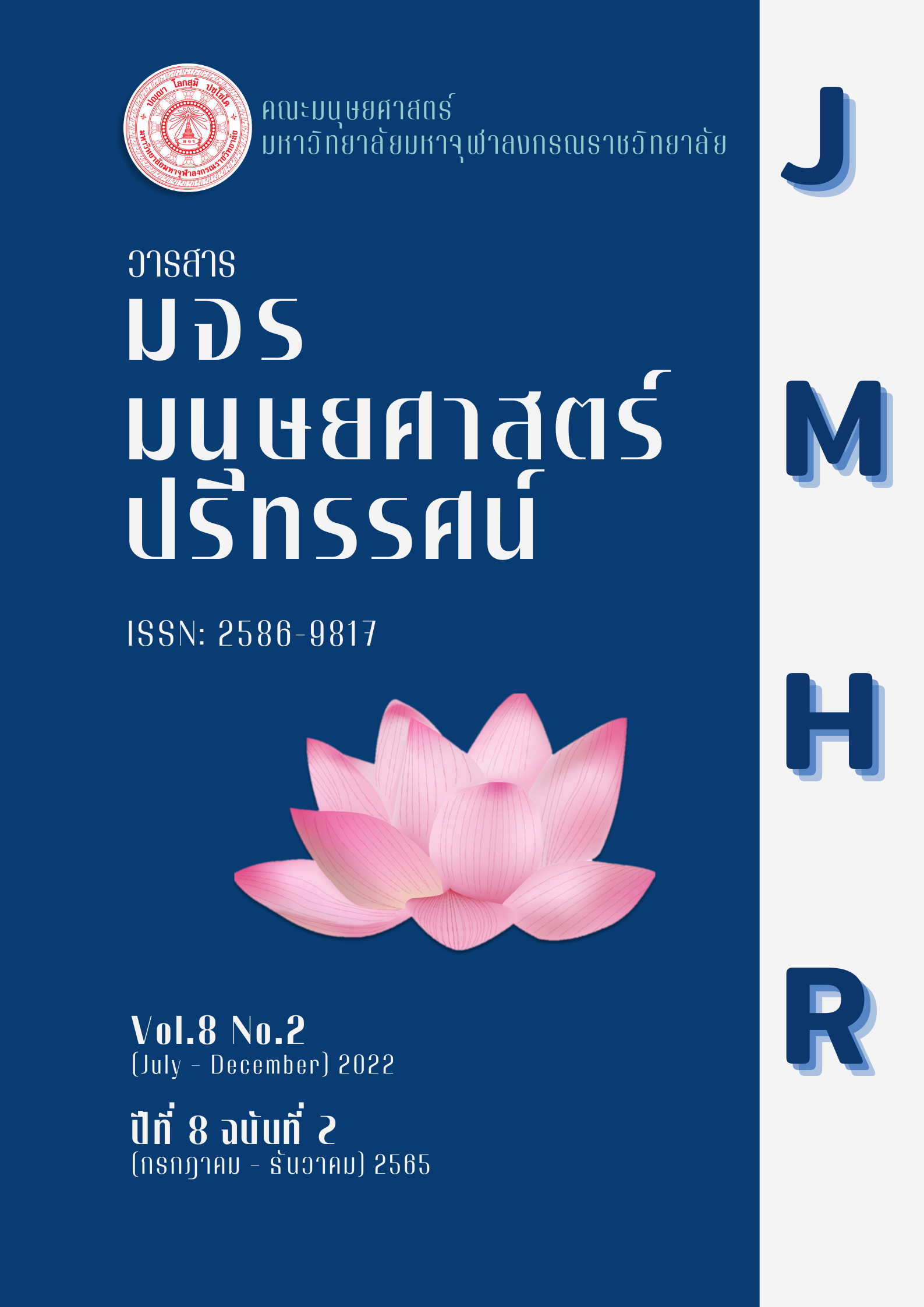ความนึกเปรียบเทียบการศึกษากับการรักษาทางการแพทย์ : มโนคติและความหลากหลายของผู้ใช้ภาษาในบริบทการศึกษาขั้นพื้นฐาน
คำสำคัญ:
ความนึกเปรียบเทียบ, การศึกษา, มโนคติ, การรักษาทางการแพทย์บทคัดย่อ
บทความนี้นำเสนอผลการศึกษาจากงานวิจัยเชิงคุณภาพ มีวัตถุประสงค์ 1. เพื่อศึกษามโนคติและรูปภาษาแสดงความนึกเปรียบเทียบ “การศึกษากับการรักษาทางการแพทย์” และ 2. เพื่อศึกษาความหลากหลายของการใช้ความนึกเปรียบเทียบ “การศึกษากับการรักษาทางการแพทย์” ของผู้ใช้ภาษาในบริบทการศึกษาขั้นพื้นฐานสมัยรัฐบาล คสช. พ.ศ. 2557-2562 เก็บข้อมูลทั้งจากภาษาที่มาจากการสื่อสารด้วยการพูดและเขียน โดยคัดเลือกแบบเจาะจง จากพระราชบัญญัติการศึกษา หัวข้อกระทู้รวมถึงถ้อยคำแสดงความคิดเห็นในแฟนเพจเฟซบุ๊กครูนอกกรอบ และเว็บไซต์พันทิปดอทคอม รวมถึงถ้อยคำจากการถอดเทปคลิปวิดีโอที่มีการสื่อสารถึงเรื่องการศึกษาจากเว็บไซต์ยูทูปดอทคอม รวมจำนวน 171 คลิป โดยใช้แบบบันทึกถ้อยคำแสดงความนึกเปรียบเทียบ “การศึกษากับการรักษาทางการแพทย์” ศึกษาถ้อยคำของบุคคล 3 กลุ่มที่เกี่ยวข้องกับระบบการศึกษา ได้แก่ ผู้มอบนโยบาย ผู้รับนโยบายมาปฏิบัติ และผู้มีส่วนได้ส่วนเสียซึ่งเป็นผลผลิตจากระบบการศึกษา ใช้แนวคิดความนึกเปรียบเทียบ และแนวคิดเรื่องความหลากหลายของภาษาในการวิเคราะห์ พบผลการศึกษา ดังนี้
- มโนคติ “การศึกษากับการรักษาทางการแพทย์” แสดงผ่านรูปภาษาความนึกเปรียบเทียบจำนวน 149 ถ้อยคำ โดยกล่าวถึง 6 องค์ประกอบของการศึกษาเปรียบเทียบกับการรักษาทางการแพทย์ ได้แก่ 1) “ผู้บริหารการศึกษาและบุคลากรทางการศึกษา” กับ “บุคลากรทางการแพทย์และผู้ป่วย” 2) “การแก้ปัญหาระบบการศึกษาและการให้การศึกษา” กับ “วิธีการรักษา” 3) “วิธีการทำงานและเนื้อหาบทเรียน” กับ “ยารักษา” 4) ปัญหาและอุปสรรคของระบบการศึกษา กับ “โรค” 5) “สภาพและความเร่งด่วนที่ต้องได้รับการแก้ไขปัญหาการศึกษา” กับ “อาการและความเร่งด่วนในการรักษา” และ 6) “ผลที่เกิดขึ้นกับระบบการศึกษา” กับ “ผลของการรักษา”
2. ความหลากหลายหรือลักษณะการแปรของภาษาไปตามปัจจัยของผู้ใช้ พบว่า การใช้ภาษาแสดงความนึกเปรียบเทียบมีการแปรไปตามสถานภาพของผู้ใช้ภาษาทั้งสามกลุ่ม ได้แก่ กลุ่มผู้มอบนโยบายทางการศึกษา จะใช้ภาษาแสดงความนึกเปรียบเทียบนี้เฉพาะในภาษาพูดเท่านั้น กลุ่มผู้รับนโยบายมาปฏิบัติ จะมีมโนคติว่าตนคือบุคลากรทางการแพทย์และผู้ป่วย และกลุ่มผู้มีส่วนได้ส่วนเสียซึ่งเป็นผลผลิตจากระบบการศึกษา จะไม่สะท้อนมโนคติยารักษาคือวิธีการทำงานและเนื้อหาบทเรียน และยังสะท้อนว่าการศึกษาอยู่ในสภาพที่ต้องการได้รับการแก้ไขปัญหาในขั้นเร่งด่วน และผลที่เกิดขึ้นกับระบบการศึกษาคืออาการรุนแรงของโรคที่ไม่สามารถรักษาให้หายเป็นปกติได้
เอกสารอ้างอิง
กระทรวงศึกษาธิการ. (2542). พระราชบัญญัติการศึกษาแห่งชาติ 2542. กรุงเทพฯ : สยามสปอร์ตฯ.
ครูบ้านนอกดอทคอม. (2560). แผนงาน/โครงการของกระทรวงศึกษาธิการที่จะดำเนินการในปี 2560. สืบค้น 10 พฤษภาคม 2563, จาก https://www.kroobannok.com/80920
ครูมะนาว ศุภวัจน์ พรมตัน. (2559). ครูเปลี่ยน นักเรียนเปลี่ยน ครูมะนาว รร.นครวิทยาคม จ.เชียงราย. สืบค้น 10 พฤษภาคม 2563, จาก https://www.youtube.com/watch?v=CL6rlpBlgso.
จรัสศรี ชินวงศ์. (2562) และ Skolpat Sensook. (2558). ครูนอกกรอบดอทคอม. สืบค้น 10 พฤษภาคม 2563, จาก https://www.facebook.com/wekruthai/photos/a
ชัชศรัณย์ จิตคงคา. (2564). ความนึกเปรียบเทียบตัวละครในนวนิยายดีเด่นแห่งชาติ (วิทยานิพนธ์ศิลปศาสตรดุษฎีบัณฑิต). มหาวิทยาลัยพะเยา : พะเยา.
ณรงค์ พิพัฒนาศัย. (2557). รมว.ศธ.แถลงนโยบายวันแรกเข้ากระทรวงศึกษาธิการ. สืบค้น 10 พฤษภาคม 2563, จาก https://www.youtube.com/watch?v=slR8_
ดวงมน จิตร์จำนงค์. (2527). สุนทรียภาพในภาษาไทย. กรุงเทพฯ : เคล็ดไทย.
ทศพล บุญธรรม. (2547). ภาวะความเครียดจากการทำงานของครูระดับมัธยมศึกษาในเขตพื้นที่การศึกษานครปฐม เขต 1 (วิทยานิพนธ์ปริญญาศิลปศาสตรมหาบัณฑิต). มหาวิทยาลัยศิลปากร : นครปฐมฯ.
ไทพับลิก้า. (2558). กระทรวงศึกษาธิการแถลงผลงานในรอบ 6 เดือน. สืบค้น 10 พฤษภาคม 2563, จาก https://thaipublica.org
พสิณ ชรัตน์. (ม.ป.ป). เอกสารประกอบการบรรยายของหน่วยบริหารทรัพย์สินและกฎหมาย “คดีทางการแพทย์”. กรุงเทพฯ : มหาวิทยาลัยมหิดล.
รัชนีย์ญา กลิ่นน้ำหอม. (2551). อุปลักษณ์ที่นักการเมืองใช้: การศึกษาตามแนวอรรถศาสตร์ปริชานและวัจนปฏิบัติศาสตร์ (วิทยานิพนธ์อักษรศาสตรดุษฎีบัณฑิต). จุฬาลงกรณ์มหาวิทยาลัย : กรุงเทพฯ.
ราชบัณฑิตยสถาน. (2545). พจนานุกรมศัพท์วรรณกรรมฯ. กรุงเทพฯ : ราชบัณฑิตยสถาน.
“_______”. (2556). พจนานุกรมฉบับราชบัณฑิตยสถาน. กรุงเทพฯ : ราชบัณฑิตยสถาน.
วิกิพิเดีย พจนานุกรมเสรี. (2564). ธีระเกียรติ เจริญเศรษฐศิลป์. สืบค้น 10 พฤษภาคม 2563, จาก https://th.wikipedia.org/wiki/ ธีระเกียรติ เจริญเศรษฐศิลป์
สมาชิกเลขที่ 1149444, 701086 สมาชิกชื่อ ม่อนหินซ้อน, ครับครับครับ. (2558). เกิดอะไรขึ้นกับระบบการศึกษาของไทย?. สืบค้น 10 พฤษภาคม 2563, จาก https://pantip.com
หมัดเหล็ก. (2560, 18 มีนาคม). โรงเรียนไอซียู ไทยรัฐ. สืบค้นเมื่อ 10 พฤษภาคม 2560, จาก https://www.thairath.co.th/news/888115
อมรา ประสิทธิ์รัฐสินธุ์. (2548). ภาษาในสังคมไทย: ความหลากหลาย การเปลี่ยนแปลง การพัฒนา. กรุงเทพฯ : จุฬาลงกรณ์มหาวิทยาลัย.
อุดมลักษณ์ เมฆาวณิชย์. (2556). ความเครียดของข้าราชการครูในสังกัดสำนักงานเขตพื้นที่การศึกษาประถมศึกษาชลบุรี เขต 2 (กลุ่มอำเภอพนัสนิคม) (วิทยานิพนธ์ปริญญารัฐประศาสนศาสตรมหาบัณฑิต). มหาวิทยาลัยบูรพา : ชลบุรี.
-Eleven Thailand. (2558). อาจารย์ใหญ่ ครูผู้ให้ The Everlasting Teacher – 7- Eleven Thailand, 2558. สืบค้น 10 พฤษภาคม 2561, จาก https://www.youtube.com/
BANGKOK HOSPITAL. (ม.ป.ป.). ห้อง ICU กับห้อง CCU ในโรงพยาบาล คืออะไร แล้วมีความแตกต่างอย่างไรบ้าง. สืบค้น 10 พฤษภาคม 2563, จาก https://www.bth.co.th
Charteris-Black, Jonathan. (2006). Britain as a container: immigration metaphors in the 2005 election campaign. Discourse & Society, 17(5): 563-581.
Nattatiti K. (2564). ระบบการศึกษาไทยปีศาจที่กัดกินความเป็นคนของครู. สืบค้น 10 พฤษภาคม 2563. จาก https://www.sanook.com/news/8358770/
Wei-lun & Ahrens. (2008). Ideological influence on BUILDING metaphors in Taiwanese Presidential speechs. Discourse & Society, 19(3): 383-40

ดาวน์โหลด
เผยแพร่แล้ว
รูปแบบการอ้างอิง
ฉบับ
ประเภทบทความ
หมวดหมู่
สัญญาอนุญาต
ลิขสิทธิ์ (c) 2022 วารสาร มจร มนุษยศาสตร์ปริทรรศน์

อนุญาตภายใต้เงื่อนไข Creative Commons Attribution-NonCommercial-NoDerivatives 4.0 International License.





